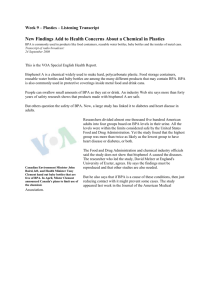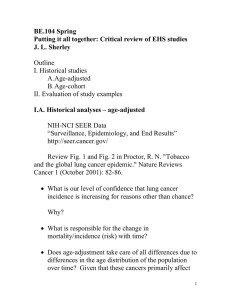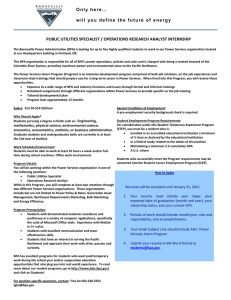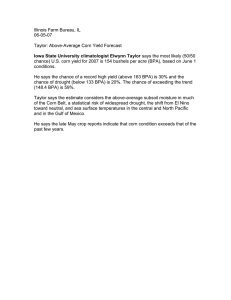Disease Watch 12 - Government of New Brunswick
advertisement
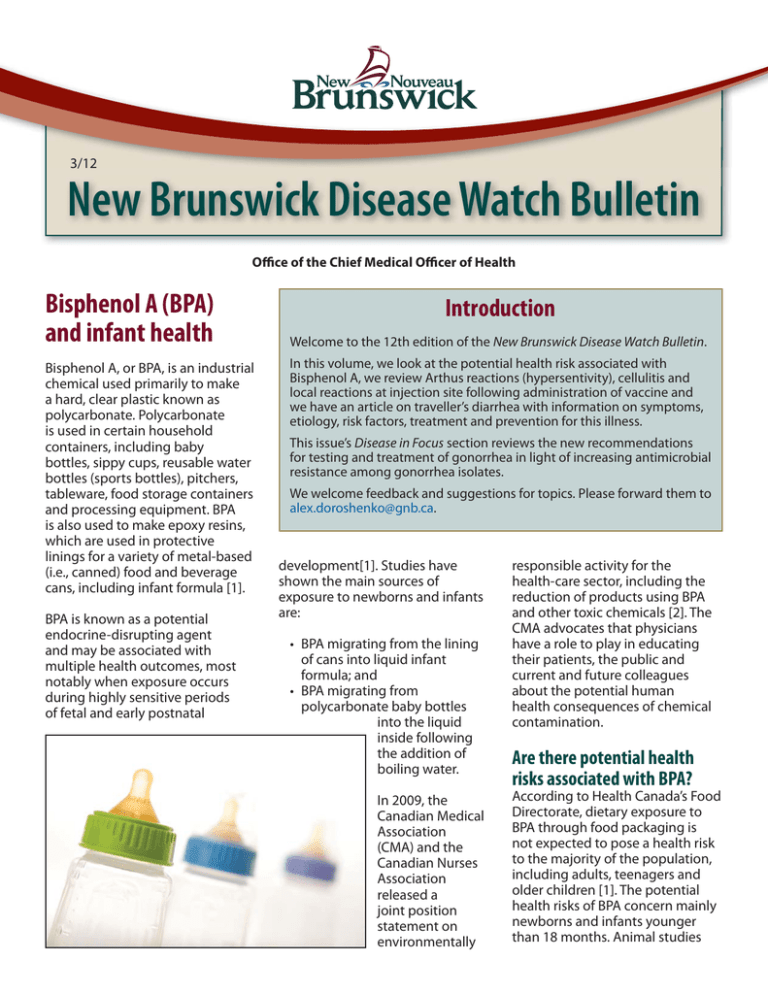
3/12 New Brunswick Disease Watch Bulletin Office of the Chief Medical Officer of Health Bisphenol A (BPA) and infant health Bisphenol A, or BPA, is an industrial chemical used primarily to make a hard, clear plastic known as polycarbonate. Polycarbonate is used in certain household containers, including baby bottles, sippy cups, reusable water bottles (sports bottles), pitchers, tableware, food storage containers and processing equipment. BPA is also used to make epoxy resins, which are used in protective linings for a variety of metal-based (i.e., canned) food and beverage cans, including infant formula [1]. BPA is known as a potential endocrine-disrupting agent and may be associated with multiple health outcomes, most notably when exposure occurs during highly sensitive periods of fetal and early postnatal Introduction Welcome to the 12th edition of the New Brunswick Disease Watch Bulletin. In this volume, we look at the potential health risk associated with Bisphenol A, we review Arthus reactions (hypersentivity), cellulitis and local reactions at injection site following administration of vaccine and we have an article on traveller’s diarrhea with information on symptoms, etiology, risk factors, treatment and prevention for this illness. This issue’s Disease in Focus section reviews the new recommendations for testing and treatment of gonorrhea in light of increasing antimicrobial resistance among gonorrhea isolates. We welcome feedback and suggestions for topics. Please forward them to alex.doroshenko@gnb.ca. development[1]. Studies have shown the main sources of exposure to newborns and infants are: • BPA migrating from the lining of cans into liquid infant formula; and • BPA migrating from polycarbonate baby bottles into the liquid inside following the addition of boiling water. In 2009, the Canadian Medical Association (CMA) and the Canadian Nurses Association released a joint position statement on environmentally responsible activity for the health-care sector, including the reduction of products using BPA and other toxic chemicals [2]. The CMA advocates that physicians have a role to play in educating their patients, the public and current and future colleagues about the potential human health consequences of chemical contamination. Are there potential health risks associated with BPA? According to Health Canada’s Food Directorate, dietary exposure to BPA through food packaging is not expected to pose a health risk to the majority of the population, including adults, teenagers and older children [1]. The potential health risks of BPA concern mainly newborns and infants younger than 18 months. Animal studies are inconclusive regarding the potential health risks of exposure to low levels of BPA. Due to this uncertainty, it is recommended that efforts to limit BPA exposure from food packaging applications specifically, to limit BPA exposure from pre-packaged infant formula products as a sole source food, be continued for this sensitive segment of the population. This recommendation is consistent with the general principle of ALARA (“as low as reasonably achievable”). Plastics identified by codes 1 through 6 do not use BPA in their manufacturing: Based on data from the 2007-09 Canadian Health Measure Survey, Statistics Canada reported that measurable levels of BPA were found in the urine of 91 per cent of Canadians aged 6 to 79, with children aged 6 to 11 years having significantly higher concentrations than older age groups [3]. There are no nationally representative data on urinary BPA concentrations among newborns and infants. International reports indicate that the highest estimated exposure to BPA by body weight occurs in infants up to six months fed with liquid formula out of polycarbonate bottles [4]. Code 7 is used to identify “other plastics,” which includes polycarbonate. Therefore, it is recommended to avoid using baby bottles that have an SPI code of 7 or do not have an SPI code at all [6]. The only way to be certain that a bottle with an SPI code of 7 does or does not contain polycarbonate is if it is labeled with its name or acronym (PC for polycarbonate) somewhere on the product or package. What is being done? Canada is the first country to take action on BPA [5]. It is now illegal in Canada to sell, advertise or import polycarbonate baby bottles and pacifiers containing BPA [7]. Periodic reviews of new information on BPA including studies of low dose effects through dietary exposure continue to be conducted by Health Canada [1]. The federal government also continues to work with the food packaging industry to reduce levels of BPA in infant formula and evaluate alternatives to BPA for formula can linings. Assessing the risk posed by baby bottles made of polycarbonate In 1988, the Society of the Plastics Industry (SPI) introduced a coding system to categorize different types of plastics [5]. According to the SPI, the coding system is to simplify sorting and recycling plastic bottles and containers. It is not directly related to health and safety. However, the SPI code may help consumers determine the suitability of certain older baby bottles and plastics for use with infant and child feeding. The code is a three-sided triangular arrow with a number 1 through 7 in the centre and letters underneath. Each number identifies the plastic from which the bottle or container is made. The SPI coding system is voluntary; not all plastic products carry a code. 1. polyethylene teraphthalate (PETE or PET); 2. high density polyethylene (HDPE); 3. polyvinyl chloride (PVC) vinyl (V); 4. low density polyethylene (LDPE); 5. polypropylene (PP); and 6. polystyrene (PS). Advice for practitioners and parents Physicians can participate in the monitoring of patients for potential health effects from chemical exposure and support medical organizations in developing tools to assess patient risk to chemical exposure [2]. Additionally, physicians and other health-care professionals can be leaders in encouraging greener health-care practices. Breastfeeding remains the healthiest choice for infants and mothers. Whether feeding expressed breast milk or infant formula, if parents and practitioners are concerned about the use of polycarbonate baby bottles, there are options. Safe alternatives include baby bottles or baby bottle liners made of the following: • polyethylene (PE), which is SPI codes 2 or 4; • polypropylene (PP) which is SPI code 5; • glass baby bottles [5]. For those continuing to use polycarbonate drinking bottles and cups, the following advice is recommended for parents and caregivers: • do not put very hot/boiling liquids in bottles for drinking, as very hot water causes BPA to migrate out of the bottle at a high rate; • bottles can be sterilized with boiling water or electric steam, or cleaned in the dishwasher, but they should be left to cool to room temperature before adding liquids; • if using infant formula, follow the instructions on the packaging labels for proper preparation, including allowing boiled water to cool to lukewarm before transferring to baby bottles; and • do not heat baby bottles in the microwave as the liquid may heat unevenly and can cause burns to infants. References 1. Health Canada, Food and Nutrition: Bisphenol A. Accessed on Dec. 19, 2011 at: <http://hcsc.gc.ca/fn-an/securit/packag-emball/bpa/index-eng.php> 2. Canadian Medical Association, CMA Position Statement: Determining the Impact of Chemical Contamination on Human Health. Accessed on Dec. 19, 2011 at: <http:// www.cma.ca/multimedia/CMA/Content_Images/Inside_cma/Office_Public_Health/ ChemicalContamination-HumanHealth_en.pdf> 3. Bushnik T et al., “Lead and bisphenol A concentrations in the Canadian population.” Health Reports, 21(3), September 2010. Statistics Canada catalogue no. 82-003-X. Ottawa. A combination of the above features is usually required to diagnose cellulitis. Cellulitis can result from bacterial contamination of vaccine vial or injection equipment; or, it can be due to the introduction of surface bacteria into the deeper layers of the skin and subcutaneous tissues [2]. Injection site cellulitis is generally seen within seven days of vaccine receipt. Cellulitis is commonly treated with antimicrobials. 4. World Health Organization, Joint FAO/WHO expert meeting to review toxicological and health aspects of bisphenol A: final report, 1-5 November 2010, Ottawa, Canada. Accessed Dec. 19, 2011 at: <http://whqlibdoc.who.int/publications/2011/97892141564274_eng.pdf> 5. Government of Canada, Chemical Substances: Bisphenol A. Accessed on Dec. 19, 2011 at: <http://www.chemicalsubstanceschimiques.gc.ca/challenge-defi/batch-lot-2/ bisphenol-a/index-eng.php> 6. Government of New Brunswick, Bisphenol A (BPA) and Infants. Accessed on Dec. 19, 2011 at: <http://www2.gnb.ca/content/dam/gnb/Departments/h-s/pdf/en/HealthyPeople/ BisphenolA%28BPA%29andInfants.pdf> 7. Government of Canada, Healthy Canadians: Baby Bottles and Pacifiers. Accessed on Dec. 19, 2011 at: <http://www.healthycanadians.gc.ca/init/kids-enfants/care-soins/bbp-bs/indexeng.php> Adverse Event Following Immunization Inflamed edematous skin at vaccine injection site: hypersensitivity to vaccine constituent, cellulitis or local reaction? An Arthus reaction (hypersensitivity) is a large, localized reaction characterized by pain, swelling, induration and edema. It usually begins within 48 hours following immunization and develops gradually over a period of hours. The reaction is due to circulating antigen-antibody complexes formed when there is a large amount of circulating antibodies prior to injection of the antigen. This results in massive swelling at the injection site that may involve the entire limb. Reporting criteria: • Onset within 48 hours of immunization; AND • Swelling extending past the nearest joint. In contrast, cellulitis is an acute, infectious inflammatory condition of the skin, located in subcutaneous tissue, fat and fascia at the injection site. Most cellulitis after immunization is the result of bacterial infection by indigenous flora colonizing the skin or by exogenous flora [1]. It is distinguished from post-injection reaction by the more intense erythema, tenderness to light touch, at least moderate induration and substantial local warmth. Arthus reaction from tetanus vaccine Source: Centers for Disease Control and Prevention Reporting criteria: • Physician-diagnosed; AND • Onset within 7 days of immunization; AND • Characterized by at least three of the following local signs or symptoms: - pain or tenderness to touch; - erythema; - induration; - swelling; - warmth. Laboratory culture results can confirm the diagnosis, but such results are seldom available. Rapid spontaneous resolution and the presence of fluctuance make cellulitis unlikely (the latter would be indicative of abscess). Success of treatment with antibiotics increases the diagnostic certainty of cellulitis for surveillance of AEFI purposes. Pain, redness, warmth and swelling at the injection site are common reactions to vaccines. Any such description of morphological or physiological change at or near the injection site described or identified by healthcare provider or other individual(s) and not meeting criteria for cellulitis or other AEFI is considered to be a local reaction. A systemic reaction which includes the injection site or lymphadenopathy near the injection site is not suggestive of local reaction [3]. When clinical signs of local reaction are more severe than usual, these events should also be reported. conjunctiva. Complications include disseminated gonococcal infection, urogenital tract abscesses, urethral strictures, pelvic inflammatory disease, epididymo-orchitis and infertility [2]. In neonates born to infected mothers, severe eye infection (ophthalmia neonatorum) may occur and lead to blindness [3]. Local reaction Source: HealthSoft, Inc. The incidence of gonorrhea in New Brunswick, specifically, is lower than that for Canada. Nevertheless, the New Brunswick rate increased to 8.5 per 100,000 in 2011 from 1.5 per 100,000 in 2001,§ with higher all-ages rates observed among males compared to females (Figure 1). Most cases occur in the 15-24 age group, with the highest rate among females in the 15-19 age group and the highest rate It is important to differentiate between hypersensitivity and infection as steps that need be undertaken to address the one would be different from what would need to be done for the other. Please refer to the provincial Adverse Events Following Immunization: Interpretation and Clinical Definitions Guide for more details about these adverse reactions and their implications at <http://www2.gnb.ca/content/dam/gnb/ Departments/h-s/pdf/en/CDC/HealthProfessionals/ AEFIsinterpretationandclinicaldefinitionsguide.pdf> References 1. Swartz MN, Pasternack MS. Cellulitis and subcutaneous tissue infections. In: Mandell GL, Bennett JE, Dolin R, editors. Mandell, Douglas and Bennett’s principles and practice of infectious diseases. 6th ed. Philadelphia, PA: Elsevier Churchill Livingstone; 2005, p. 11721194 2. Halperin S, Kohl KS, Gidudu J, Ball L, Hammer SJ, Heath P, Hennig R, Labadie J, Rothstein E, Schuind A, Varricchio F, Walop W; Brighton Collaboration Local Reaction Working Group for Cellulitis at Injection Site. Cellulitis at injection site: case definition and guidelines for collection, analysis, and presentation of immunization safety data. Vaccine. 2007; 25(31):5803-20. 3. Gidudu J, Kohl KS, Halperin S, Hammer SJ, Heath PT, Hennig R, Hoet B, Rothstein E, Schuind A, Varricchio F, Walop W; Brighton Collaboration Local Reactions Working Group for a Local Reaction at or near Injection Site. A local reaction at or near injection site: case definition and guidelines for collection, analysis, and presentation of immunization safety data. Vaccine. 2008; 26(52):6800-13. Emergence of antimicrobial resistance in Neisseria gonorrhea Gonorrhea remains a significant public health problem worldwide and in Canada. It is the second most commonly reported bacterial sexually transmitted infection in Canada, with more than 11,000 cases reported in 2009, representing a rate of 33.1 per 100,000 [1]. Gonorrhea spreads efficiently through unprotected sexual activity, including vaginal or anal intercourse and oral sex. The organisms’ primary sites of infection involve the mucous membranes of urethra, endocervix, anal crypts, pharynx and among males in 20-24 age group (Figure 2)§ [4]. Since the introduction of antibiotics in 1930s, Neisseria gonorrhea exhibited an ability to acquire novel genetic resistance determinants [5,6]. By the end of 1940s, nearly 90 per cent of Neisseria gonorrhea isolates were microbiologically resistant to sulfonamides, the first antimicrobial used to treat gonorrhea. Penicillin was used to treat gonorrhea since 1943 as an alternative to sulfonamides; however, the emergence of penicillinase-producing gonococci soon rendered penicillin ineffective. Resistance to tetracyclines emerged as a result of mutations in various genes impairing tetracyclines’ binding and interaction with bacterial ribosome, the effect called ribosomal protection. Spectinomycin and aminoglycosides were marketed for treatment of gonorhhea in the early 1960s; however, resistance developed as a result of drug-specific single-step mutations in genes, resulting in modification of bacterial ribosomal target. Fluoroquinolones, such as ciprofloxacin and ofloxacin, were used to treat gonorrhea from the mid-1980s. Resistance occurred due to mutations mostly in gyrA and to parC genes, leading to altered DNA gyrase and topoisomerase IV enzymes, which are essential for fluoroquinolones’ antimicrobial effects. Quinolones resistance was first seen in Asia-Pacific region and subsequently spread around the world. Quinoloneresistant gonococci are particularly prevalent among men-who-have-sex-with-men (MSM). In recent years, cephalosporins (Ceftriaxone by intramuscular injection and Cefixime orally) have been used a first line of treatment of Neisseria gonorrhea infection [3]. Clinical failures of treatment with first-line cefixime are increasingly reported in the literature [7,8]. Although none of the 10,993 Neisseria gonorrhea isolates tested at the Public Health Agency of Canada (PHAC) between 2000 and 2009 was resistant to cefixime or ceftriaxone, the minimum inhibitory concentration (MIC)† of ceftriaxone and cefixime gradually increased from 2000 to 2009, indicating reduced susceptibility [9]. In December 2011, PHAC published an update to the clinical guidelines for the management of gonococcal infection. Based on safety, efficacy and rising ceftriaxone and cefixime minimum inhibitory concentrations (MIC), it is recommended that higher doses of cephalosporins be used (i.e., a single dose of ceftriaxone 250 mg intramuscularly or cefixime 800 mg‡ orally for individuals nine years of age or older) to reduce the risk of gonococcal treatment failure. Due to recent cases of cefixime treatment failures reported primarily in MSM, ceftriaxone 250 mg intramuscularly is recommended as the preferred treatment for gonococcal infections in this population. Quinolones such as ciprofloxacin and ofloxacin are no longer recommended for the treatment of gonococcal infections in Canada. Quinolones may be considered in settings of anaphylaxis to penicillin or known hypersensitivity to a third generation cephalosporin and only if antimicrobial susceptibility testing is available and quinolone susceptibility is demonstrated. Empiric treatment for chlamydia is recommended for all patients treated for gonococcal infection regardless of chlamydial test results because of the high co-infection risk. A one-gram single oral dose of Azithromycin is the preferred chlamydia co-treatment option due to the dual cephalosporinazithromycin therapeutic effect on gonorrhea, significant rates of tetracycline-resistant gonorrhea and concerns regarding compliance with a seven-day doxycycline treatment. However, oral doxycycline as an alternate treatment option for chlamydia may be used at 100 mg twice a day for seven days if compliance is not a concern [10]. Summary of new recommendations on gonorrhea treatment and chlamydia co-treatment in adults Gonorrhea treatment Preferred treatment Alternative treatment Ceftriaxone 250 mg intramuscularly single dose or cefixime 800 mg‡ orally single dose. Quinolones may be considered in settings of anaphylaxis to penicillin or known hypersensitivity to a third generation cephalosporin and only if quinolone susceptibility is demonstrated. In MSM population Ceftriaxone 250 mg intramuscularly single dose Chlamydia co-treatment Azithromycin 1 g orally single dose Doxycycline 100 mg orally twice daily for 7 days In light of increasing antimicrobial resistance of Neisseria gonorrhea, and to improve public health surveillance of gonococcal antimicrobial resistance, clinicians are requested to perform gonorrhea culture in symptomatic MSM prior to treatment (in addition to NAAT testing) as well in cases of pharyngeal infection, persistent symptoms or signs post-treatment, in cases treated with non-preferred regimes or in cases linked to drug resistant/treatment failure case. For more details on updated guidelines for the management of gonorrhea, refer to <www.phac-aspc.gc.ca/std-mts/ sti-its/alert/2011/alert-gono-eng.php>. Neisseria gonorrhoeae in a cervical smear using the Gram-stain technique Source: CDC/Joe Miller Gonococcal infection is a reportable disease under the Public Health Act (2009) and regulations in New Brunswick [11]. Reports are usually sent from laboratories to the regional Public Health offices within seven days of laboratory confirmation. Clinicians are encouraged to report clinically suspected or known cases of antibiotic resistant Neisseria gonorrhea infections (e.g., treatment failures) to the Regional Medical Officers of Health. § † ‡ 2011 figures are preliminary and subject to change In microbiology, minimum inhibitory concentration (MIC) is the lowest concentration of an antimicrobial that will inhibit the growth of a microorganism. A lower MIC is an indication of a better antimicrobial agent. Cefixime 800 mg is higher than the dosage listed in the product monograph for the treatment of gonococcal infection. References 1. Public Health Agency of Canada. Reported cases and rates1 of gonorrhea by province/ territory and sex, 1980 to 2009. Accessed on January 26, 2012 at: <http://www.phac-aspc. gc.ca/std-mts/sti-its_tab/gonorrhea_pts-eng.php> 2. Hook EW III, Hunter HH. Gonococcal infections in the adult. In: Holmes KK, Sparling PF, Stamm WE, et al. Sexually transmitted diseases. 4th edn. New York: McGraw-Hill Companies Inc, 2008:627-45. 3. Public Health Agency of Canada. Canadian guidelines on sexually transmitted infections. Accessed on January 26, 2012 at: <http://www.phac-aspc.gc.ca/std-mts/sti-its/ pdf/506gonococcal-eng.pdf> 4. Office of the Chief Medical Officer of Health. Department of Health, New Brunswick. RDSS database 5. Lewis DA. The Gonococcus fights back: is this time a knock out? Sex Transm Infect. 2010; 86(6):415-21. 6. Deguchi T, Nakane K, Yasuda M, Maeda S. Emergence and spread of drug resistant Neisseria gonorrhoeae. J Urol. 2010; 184(3):851-8 7. Unemo M, Golparian D, Syversen G, Vestrheim DF, Moi H. Two cases of verified clinical failures using internationally recommended first-line cefixime for gonorrhoea treatment, Norway, 2010. Euro Surveill. 2010; 15(47):pii-19721. 8. Kirkcaldy RD, Ballard RC, Dowell D. Gonococcal resistance: are cephalosporins next? Curr Infect Dis Rep. 2011; 13(2):196-204. 9. Martin I, Jayaraman G, Wong T, Liu G, Gilmour M, Canadian Public Health Laboratory Network. Trends in antimicrobial resistance in Neisseria gonorrhoeae isolated in Canada: 2000-2009. Sex Transm Dis. 2011; 38(10):892-8. 10. Public Health Agency of Canada. Public health information update on the treatment for gonococcal infection. Accessed on January 26, 2012 at: <http://www.phac-aspc.gc.ca/stdmts/sti-its/alert/2011/alert-gono-eng.php> 11. Government of New Brunswick. New Brunswick regulation 2009-136 under the Public Health Act (O.C. 2009-455). Accessed on January 26, 2012 at: <http://laws.gnb.ca/en/ showfulldoc/cr/2009-136//20120126> Travellers’ diarrhea Travellers’ diarrhea (TD) is common among those who visit less industrialized countries, occurring in up to 60 per cent of travelers [1]. Although most cases of TD are self-limiting and resolve within a few days, activities may be disrupted, and some travellers will return home with acute or persistent diarrheal illness. Symptoms TD is a clinical syndrome defined by three or more unformed stools in 24 hours and at least one additional enteric symptom such as nausea, vomiting, cramping, abdominal pain or fever. In more severe cases, stools may contain mucus or blood. Illness usually occurs within the first week of travel, but symptoms can occur later or even after return from travel. Symptoms are normally self-limiting and resolve within two to five days without treatment. Up to 10 per cent will persist longer than two weeks [2]. Complications include dehydration and chronic intestinal complaints, such as post-infectious irritable bowel syndrome [3,4]. Etiology Bacterial enteropathogens are responsible for more than 80 per cent of TD cases with enterotoxigenic Escherichia coli (ETEC) and enteroaggregative E. coli (EAEC) believed to cause the majority of cases [4,5]. Shigella spp., Campylobacter spp., Salmonella spp., Aeromonas spp., Yersinia spp., and Vibrio cholerae are other well-established bacterial causes of TD. Viral causes of TD include Norwalk or norovirus, rotavirus, adenoviruses and hepatitis A virus. Vomiting is typically due to viral infection or ingestion of preformed toxins of Staphyloccocus aureus or of Bacillus cereus. Protozoan causes of TD include Giardia lamblia, Entamoeba histolytica, Cryptosporidium parvum, and Cyclospora cayetanensis and are usually associated with prolonged or chronic diarrhea [3,4]. Protozoan causes of TD are uncommon, accounting for just five per cent of cases of TD and more likely to affect individuals who stay in developing countries for long periods [6,7]. A causative agent is not isolated from 20 to 50 per cent of cases. However, self-limited disease or response to empiric antibiotic treatment suggests presence of an undetected bacterial pathogen in most of these cases [5,7]. Travel-associated diarrhea that persists for longer than seven days should be evaluated by stool culture for pathogens, including C&S for bacterial cultures and O&P for parasite microscopy. In New Brunswick, routine C&S screening tests for Salmonella spp., Shigella spp., Campylobacter spp. and E. coli 0157:H7. Some laboratories also test for Yersinia spp. New Brunswick laboratories do not routinely test for non0157:H7 strains of E. coli. from street vendors is not recommended. The rule of thumb is, “boil it, peel it, cook it, or forget it.” Non-infectious causes of diarrhea should also be considered: for example, recent dietary changes, changes of medications, ingestion of medications from unknown origin or undiagnosed gastrointestinal conditions such as irritable bowel syndrome or celiac disease [2]. Sealed carbonated beverages, beer and wine are low risk. All water should be boiled or treated before consumption, including for infant formula, washing fruits and vegetables and brushing teeth. Bottled water and juices should be purchased from reputable supermarkets and restaurants, not from street vendors. Ice should be considered unsafe. Proper and frequent hand washing or use of alcohol-based hand sanitizers will also reduce risk of infection. Risk factors The most important risk factor for TD is international travel to a region with poor environmental hygiene. Risk is directly associated with duration of travel in such relatively unhygienic environments and also tends to be higher during the summer and rainy seasons [3,7]. High-risk areas include most of Asia, the Middle East, Africa, Mexico and Central and South America. Intermediate-risk countries include those in Eastern Europe, South Africa and some of the Caribbean islands. United States, Canada, Australia, New Zealand, Japan and countries of Northern and Western Europe are low-risk areas [8]. Food and water are the principal vehicles for TDcausing pathogens. In developing countries, meals prepared in restaurants are considered higher risk than eating in a private home due to lack of licensing, enforcement and inspection policies, as well as lack of food handler training. Eating food obtained from street vendors is particularly risky [3]. Pathogens can also be transmitted through contaminated recreational waters; through close contact with an infected individual; or through sexual activities that permit fecal-oral transmission [6]. Excessive consumption of alcohol, underlying gastrointestinal disorders and use of drugs that reduce stomach acidity are also risk factors [3,4]. Risk of disease and severity of illness depend on the infectious dose of the agent and the number of organisms consumed. For example, ingestion of as few as 10 Giardia or Shigella organisms or as many as one million Salmonella organisms may be needed to reach the threshold for infection [9]. Prevention Safe practices related to food and beverage consumption will reduce risk of TD while traveling in developing countries. Travelers are recommended to eat only steaming hot and freshly cooked foods; thoroughly washed and peeled fruits and vegetables; and foods that have minimal moisture content (e.g., bread) or high sugar content (e.g., jams, candy). Eating Bismuth subsalicylate (BSS), an active ingredient of Pepto-Bismol and non-antimicrobial medication, has been shown to reduce incidence of TD with minimal side-effects at a short-term dosage of two chewable tablets or 2 oz of liquid four times daily. BSS should not be used as prophylaxis by children younger than 3 years of age and with viral infections, such as varicella or influenza, because of the risk of Reye syndrome; by those who are taking other salicylate-containing medications or anticoagulants; and those with chronic renal insufficiency or gout [7]. BSS can cause blackening of the tongue and stool and may cause nausea, constipation and tinnitus. It should not be used for longer than 3 weeks. Lactobacillus probiotic has been used for prophylaxis, however studies on its effectiveness are inconclusive and standardized preparations of these bacteria are not reliably available [8]. Use of antibiotics as prophylaxis is not recommended for most travelers except in special circumstances, such as for immunocompromised travelers. Use of antibiotics has been shown to reduce the incidence of TD, however antibiotic prophylaxis affords no protection against non-bacterial pathogens and may lead to adverse reactions. In most cases early selftreatment (versus prophylaxis) can limit the duration of illness to 6-24 hours [8]. Antimotility agents should never be used for prophylaxis because of potential toxicity [3]. Few vaccines are available for the prevention of TD. The Public Health Agency of Canada recommends hepatitis A immunization for all travelers to developing countries, especially to endemic regions. Cholera is an uncommon cause of TD. However, the oral cholera vaccine (Chol-Ecol-O, DukoralTM) has been shown to provide short-term protection against Enterotoxigenic E.coli. Typhoid vaccine is only recommended for extended travel to nontourist regions of countries with high incidence of disease [10]. The Public Health Agency of Canada’s recommendations for travelers can be found at <www. phac-aspc.gc.ca/tmp-pmv/info/diarrhea-eng.php>. Treatment Fluid and electrolyte replacement are the mainstay treatment of TD. Proper hydration and use of oral rehydration salts should be encouraged, particularly for young children and individuals with vomiting or chronic diarrhea. Many cases of travelers’ diarrhea in healthy travelers are self-limiting and will resolve with hydration measures. Antibiotics and antimotility agents may be used to treat prolonged or more severe cases of travelers’ diarrhea or in individuals with underlying health problems. Fluoroquinolones (e.g., ciprofloxacin or levofloxacin with a single dose or 1-day therapy) are a widely used antimicrobial therapy to treat bacterial TD. However, use of azithromycin is increasing due to emerging resistance to fluoroquinolones, especially among Campylobacter isolates. A single dose of 1 g of azithromycin or 500 mg daily for 1-3 days are regimes used. Azithromycin is also considered to be the first line therapy in children. Rifaximin is approved in the USA for the treatment of non-invasive TD since 2004 [11]. However its overall usefulness is not determined as it is difficult for travelers to distinguish between invasive and non-invasive diarrhea [9]. Rifaximin is currently not approved in Canada. Treatment of protozoan TD is guided by the parasite; metronidazole, tinidazole, trimethoprim-sulfamethoxazole and paromomycin are used. Use of antimotility agents such as loperamide (i.e., Imodium) must be limited to 48 hours and should not be given to young children or when fever or bloody stool is present. When used in combination with antimicrobial therapy, antimotility agents can decrease severity and duration of symptoms. Medications purchased in developing countries may not be genuine and may be unsafe to take. Where feasible, travelers should consult local medical practitioners for appropriate use of medications or if diarrhea persists or worsens. In some instances, travelers to high-risk regions are advised to carry antimotility agents and antibiotics from home. Option for self-treatment should be discussed prior to travel, particularly in travelers to remote area with limited access to medical care. References 1. Hill, D.R. and Beeching, N.J. Travelers’ Diarrhea. Curr Opin Infect Dis 2010;23:481-487. 2. Kolars, J.C. and Fischer, P.R. Evaluation of diarrhea in the returned traveller. Prim Care Clin Office Pract 2002;29:931-945 3. Kamat, D. and Mathur, A. Prevention and management of Travellers’ Diarrhea. Dis Mon 2005;52(7):289-302. 4. Dupont, H.L. New insights and directions in Travellers’ Diarrhea. Gastroenterol Clin N Am 2006; 35:337-353. 5. Shlim, D.R. Update in Traveller’s Diarrhea. Infect Dis Clin N Am 2005;19:137-149. 6. Jong, E. Intestinal parasites. Prim Care Clin Office Pract 2002;29:857-877 7. Diemert, D.J. Prevention and self-treatment of travellers’ diarrhea. Prim Care Clin Office Pract 2002;29:843-855. 8. Centers for Disease Control and prevention. CDC Health information for international travel 2012. Atlanta: US. Department of Health and Human Services, Public Health Service, 2012. Available at <http://wwwnc.cdc.gov/travel/yellowbook/2012/chapter-2-the-pre-travelconsultation/travelers-diarrhea.htm> Accessed on January 30, 2012 9. Heymann DL. Control of Communicable Diseases Manual. 19th ed. Washington, DC: American Public Health Association; 2008. 10. Public Halth Agency of Canada (PHAC). Canadian Immunization Guide, 7th Edition. 2006; Accessed on Dec. 8, 2011 at: <www.phac-aspc.gc.ca/publicat/cig-gci/p03-10-eng.php> 11. Food and Drug Administration. Rifaximin Label and Approval History. Accessed on January 30, 2012 at: <http://www.accessdata.fda.gov/drugsatfda_docs/label/2004/21361_ xifaxan_lbl.pdf>
